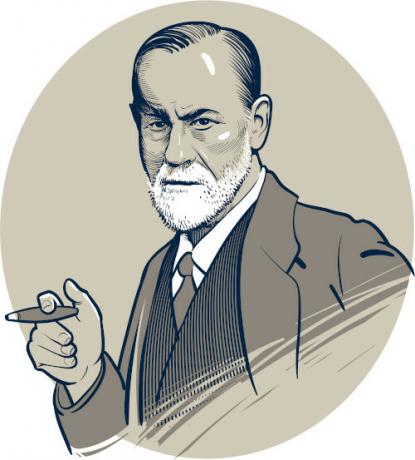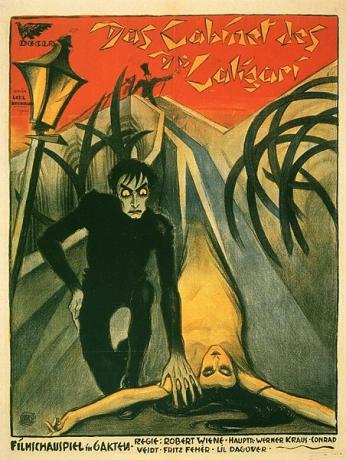O expressionism is an avant-garde artistic movement that took place at the beginning of the 20th century, in the context that involved the First World War. In outright opposition to iimpressionism, this movement is characterized by irrationality and individualism, in addition to presenting a pessimistic view of reality, in order to misrepresent the real.
Expressionist aesthetics can be identified in various types of artistic expression, however, in painting, it was more striking. In Europe, its main representative is Edvard Munch, with his famous work The Scream. In Brazil, modernist painters such as Candido Portinari and Tarsila do Amaral also produced works with an expressionist influence. In literature, on the other hand, names such as Thomas Mann and Mário de Andrade wrote works with expressionist traits.
Read too: Dadaism – avant-garde that foresaw a total break with the structure traditional
Historical context and origin of expressionism
O early 20th century it was marked by the use of technological innovations, such as the telephone, wireless telegraph, the automobile and the plane, which allowed for faster communication and transport. A new world, characterized by the
technology and for velocity, was presented to the population. The theory of relativity, from Albert Einstein (1879-1955), and the emergence of psychoanalysis, with Sigmund Freud (1856-1939), expanded the way in which time, space and the human mind were understood until then.
So it was a time of uncertainties, characterized by the questioning of truths hitherto considered unquestionable, which suggested that there was much more to be discovered and that the new century was a sea of possibilities. However, in addition to this scientific and intellectual movement, there was also the tension between the great powers, which sought to maintain, each one, its hegemony.
In this context, the European vanguards, that is, movements that questioned the academic values up until then defended in art. Each of these movements intended to bring a new artistic perspective, a new way of making art, as opposed to what is considered traditional. Among them was expressionism, born in Germany in 1910, but which ended up being influenced, too, by the events of First World War.
Like other avant-garde movements, expressionism also launched a manifesto. The Expressionist Manifesto was released in 1918 and signed by Kasimir Edschmid (1890-1966). In this document, he defends that the expressionist aesthetic is the result of personal experience of the artist associated with the search for something new. The originality of the work, then, is in the individual perception (therefore, unique) of reality.
Characteristics of expressionism
Expressionism is an artistic movement that opposes the impressionism and defends the loss of conscious control in the act of creation so that reality is transformed by the artist's particular expression (vision). Thus, it presents these characteristics:
Focuses on the dark side of humanity;
It reveals existential anguish and fear;
It is anti-positivist, as it defends irrationalism;
Values intuition over reason;
Expresses an individual perception of reality;
Values subjectivity over objectivity;
It has a pessimistic character and deals with themes such as loneliness;
Realizes the distortion of reality;
Defends individual freedom;
It seeks to show the misery of the human species;
It values the metaphysical aspect.
Read too: Cubism – avant-garde that valued geometric shapes
Main artists of expressionism
O expressionism exerted influence over several authors, in several artistic areas, such as:
Architecture:
Bruno Taut (1880-1938): glass pavilion (1914).
Erich Mendelsohn (1887-1953): complex woga (1926-1931).
Fritz Höger (1877-1949): chilehaus (1922-1924).
Sculpture:
Ernst Barlach (1870-1938): Have mercy! (1919).
Wilhelm Lehmbruck (1881-1919): kneeling woman (1911).
Painting:
Edvard Munch (1863-1944): The Scream (1893)|1|.
Käthe Kollwitz (1867-1945): the widow I (1921).
Literature:
Thomas Mann (1875-1955): Doctor Faust (1947).
James Joyce (1882-1941): Ulysses (1922).
Alfred Doblin (1878-1957): Berlin Alexanderplatz (1929).
Rainer Maria Rilke (1875-1926): Letters to a young poet (1929).
Georg Kaiser (1878-1945): the bourgeois of Calais (1913).
Movie theater:
Robert Wiene (1873-1938): Dr. Caligari's office (1920).
Fritz Lang (1890-1976): metropolis (1927).
Friedrich Wilhelm Murnau (1888-1931): nosferatu (1922).
expressionist arts
The expressionist movement influenced various forms of artistic expression. However, his relationship with painting is the most striking and original, not least because of his opposition to Impressionism.
THE painting The Scream, Edvard Munch's most famous work and the main representative of expressionism, brings existential anguish stamped on the face and scream of a misshapen character. As a background, a sunset in Oslo, Norway. It is possible to observe, on the screen, the distorted and aggressive lines, with strong and unreal colors, in order to express, emotionally, the artist's individual vision in relation to reality.

In turn, the expressionist literature addresses the decadence of the bourgeois world and capitalist, it points out the imbalances of reality and the impotence of the human being in face of it. Thus, it resorts to grotesque and distorted images of the real, from a negativist perspective.
With this in mind, inDoctor Faust, by Thomas Mann, from the excuse of making a biography of a composer, the narrator reflects on the artist inserted in (and in conflict with a) German bourgeois society in its inevitable catastrophe of selling its soul to the devil (to Nazism).
already in seventh Art,Dr. Caligari's office, by Robert Wiene, is a copy of movie theater mute horror, whose setting and photography privilege the shapeless. Caligari holds a doctorate in sleepwalking (hypnotism). His arrival in a German village is accompanied by mysterious murders and predictions of the future. In the end, the story ends up being characterized by the irrationality of madness.

Expressionism in Brazil
THE painting of brazilian modernism was influenced by European vanguards. In this way, it is possible to verify traces of these movements in several works, including, among them, the expressionism. As an example, we can point out:
Anita Malfatti (1889-1964): the wind (1915-1917).
Candido Portinari (1903-1962): retreatants (1944).
Di Cavalcanti (1897-1976): Friends (1921).
Ismael Nery (1900-1934): portrait of Murilo Mendes (1922).
Lasar Segall (1889-1957): Self portrait I (1911).
Tarsila do Amaral (1886-1973): Portrait of Oswald de Andrade (1922).
Ernesto de Fiori (1884-1945): The friends (s. d.).
Flávio de Carvalho (1899-1973): Portrait of Jorge Amado (1945).

As for the Brazilian literature, there are not, properly, expressionist works. Some critics, however, point out characteristics of this movement in some works of Brazilian modernist (and even pre-modernist) literature, whose authors would have been influenced by the expressionism. As an example, it is possible to mention:
Graciliano Ramos (1892-1953): Anguish (1936);
Augusto do Anjos(1884-1914): Me (1912);
Mario de Andrade (1893-1945): love, intransitive verb (1927).
in the poem “Nocturnal Complaints” (1906), from the book Me, by Augusto dos Anjos, it is possible to perceive a more aggressive tone when the lyrical self speaks of humanity.|2| As we know, expressionism is characterized by this aggressiveness, in addition to the distortion of reality, as it is configured in the particular view of the author of the work:
Night Complaints
[...]
My clothes, I even want to break them!
I want, plucked from carnal prisons,
Living in the light of the immortal stars,
Embraced with all the stars!
The night grows terrifying
And inside my chest, in combat,
crushing eternity hits
In an exorbitant expansion!
[...]
that inside my american soul
No more heartbeat — this ark,
This tragic clock that marks
All acts of human tragedy!
[...]
In Anguish, by Graciliano Ramos, the protagonist is Luís da Silva, a man close to middle age, a public servant, lonely and melancholy. THE anguish title of the book refers to that character's state of mind. O narrator character have your private view, therefore, distorted from reality. It's just that inner world by Luís da Silva who gives the work its expressionist character: “I live restless, full of terrors, a trembling in my hands, which have become thin. The hands are no longer mine: they are old, weak and useless hands. The abrasions on the palms have healed.”
Already love, intransitive verb, by Mário de Andrade, tells the story of Fräulein Elza, a German woman supposedly hired to be a governess in a house in the São Paulo bourgeois elite from the beginning of the 20th century, but that, in fact, she is a “teacher of love”, paid to take the virginity and innocence of young Carlos, a fifteen-year-old teenager. In this work, the decadence of the bourgeois world and the distorted view that the German character has in relation to her profession and also to Brazilian culture:
“Fräulein, for the days ahead, thought twice at length about the case. Seriously. [...]. Her mission was not to direct an act: taught integral love, so unnatural in these times... Calm love, etc. With the frequency of the ideal written by the imprisoned god, certainly a disciple of Hans Sachs, Fräulein little by little had mechanized his poor conception of love. There, the man-of-life and the man-of-the-dream came to confuse themselves in the preaching of a single truth and, even funnier still, in the vision of the same picture. teacher of love... but he wasn't born for it, he knew. Circumstances had made her the teacher of love, she had adapted. I didn't even discuss if I was happy, did not realize his own unhappiness. It was, verb to be.”
See too: Futurism – vanguard with a strong patriotic and technological tone
solved exercises
question 1





All these images have traces of expressionism, except:
a) Image 1
b) Image 2
c) Image 3
d) Image 4
e) Image 5
Resolution
Alternative E.
Image 5 is a Cubist painting, as it favors geometric shapes. The first four, on the other hand, have marks of expressionism, that is, denser and more twisted lines, not objective, therefore more associated with emotion.
Question 2 - Point out the alternative that has an expressionist characteristic:
The) nonsense.
b) Individualism.
c) Geometrism.
d) Mechanization.
e) Oneirism.
Resolution
Alternative B.
Individualism characterizes expressionism, as this movement argues that art is the artist's particular, subjective and irrational vision.
*Image credit 5: tichr / Shutterstock
Grades
|1| The year 1910 officially marked the emergence of expressionism. Nonetheless, The Scream it is one of the most famous expressionist works and, as can be seen, it was produced well before the formalization of the movement.
|2| Thesis defended by José Maria Pinto de Figueiredo, master in Literary Studies.
by Warley Souza
Literature teacher
